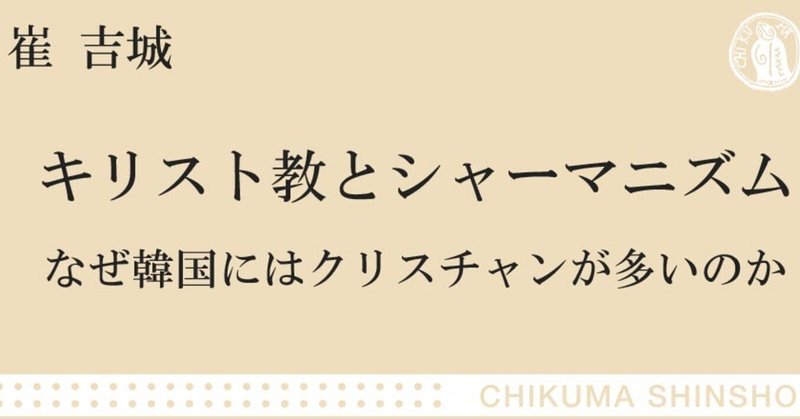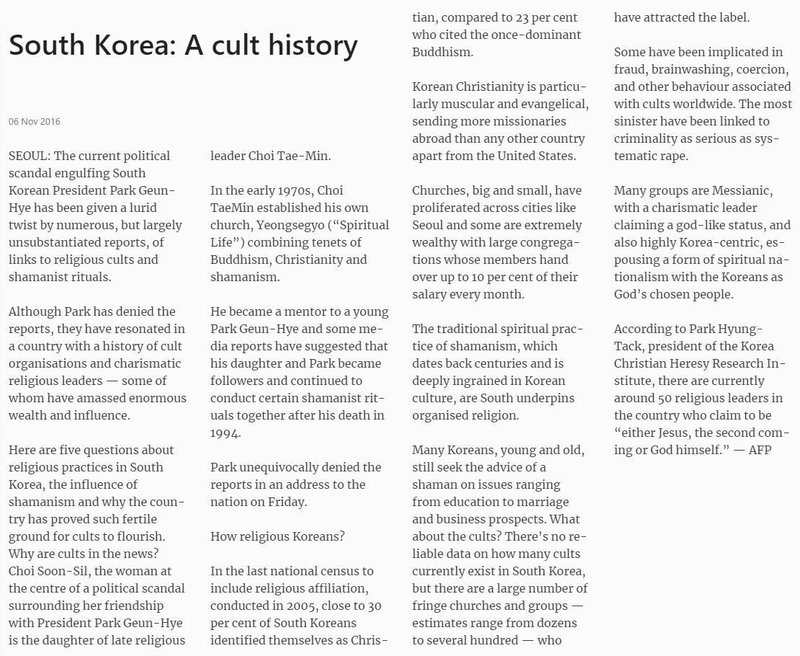
キリスト教化したシャーマニズム・シャーマニズム化したキリスト教(韓国)
(前略)
私の母はシャーマニズム信仰が強かった。父は儒教的な人で母の信仰に賛成したわけではないが子供の健康を祈る母に反対はしなかった。私は母の信仰から強い影響を受けて16歳までシャーマンの家を母とともに訪ねていた。母は毎年、中部地域で有名な神山である紺岳山(カマクサン)にシャーマンと一緒に行って祈りと儀礼を依頼していた。母は幼い私を同行させた。私は学校で教育を受けるにつれてシャーマニズムを遠く避けるようになり、批判的になった。そしてクリスチャンになった。多くのキリスト教会はシャーマニズムを迷信として扱った。しかし、シャーマニズムは消滅するものではなく、キリスト教会の核心部分において信仰として生き残っていることが分かった。多くのキリスト教会が土着化する中でシャーマニズム化する現象が起きているのである。教会の中で病気治療のための祈りなどはシャーマニズムと変わりがない。
(後略)
(前略)
キリスト教は普遍的な世界宗教であるが地域によっては民族中心に土着化されている。韓国のキリスト教はシャーマニズムと混合している。つまりキリスト教の聖霊運動はシャーマニズムのトランス(憑霊)やエクスタシー(脱魂)の要素が含まれているのが常である。キリスト教会にはシャーマニズムとキリスト教が共存あるいは混在するようであり、日本人には新宗教のように感じるかも知れない。私はシャーマニズムを迷信と思い、キリスト教へ改宗したが再び教会の中でシャーマニズムを見るような感がある。私がシャーマニズムを研究しながらクリスチャンであるということに矛盾を感じることもあろうが、それは私だけのことではない。多くのクリスチャンはシャーマニズムを迷信だと思いながらその中にシャーマニズムが埋没されている事に気がつかない。私にとって母が篤信していたムーダン(シャーマン)の儀礼などは幼いころから馴染深いものであった。
(後略)
パーティー券疑獄(自民党)の報道に多くの時間と紙面・誌面が費やされているこの年末の移動中に、崔吉城(チェ・ギルソン)東亜大学教授・広島大学名誉教授著『キリスト教とシャーマニズム - なぜ韓国にはクリスチャンが多いのか』(ちくま新書)を読みました。たいへん勉強になりましたが、出版後2年余りしか経っていない書籍の内容を引用することは控えます。ご興味があれば、是非(オンライン)書店で手に取ってご覧ください。
以前の記事『文鮮明師からセウォル号まで 韓国はキリスト教カルト天国 - 新潮45(2014年9月号)』を初め、これまで何度かふれましたが、朝鮮半島には、数世紀~十数世紀の歴史を経たカトリック教会やプロテスタント教会と並んで、基督教化したシャーマニズムやシャーマニズム化した基督教が乱立しているようです。また、教祖が再臨のイエスや救世主や(一神教の)神を自称する集団も多数存在するようです。
内容を引用するのを控えた書籍の代わりに、朴槿恵(パク・クネ)元大統領が失職する原因となった崔順実(チェ・スンシル)ゲート事件が発覚した当時にAFPが配信した記事の Google 翻訳を本稿末尾に引用します。お時間があれば...
他国で伝承されたシャーマニズムに惑わされることのないよう、殊に宗教?については関係者の日本への出入国を規制する必要があるかもしれません。

韓国:カルトの歴史
2016年11月4日発行 2016年11月4日更新
ソウル - 韓国の朴槿恵大統領を巻き込んだ現在の政治スキャンダルは、カルト宗教やシャーマンの儀式との関連を示す多数のしかし大部分は裏が取れていない報道によって、不気味な展開が加わっている。
朴大統領はこれらの報道を否定しているが、カルト組織や(中には莫大な富と影響力を蓄えた者もいる)カリスマ的な宗教指導者の歴史を持つ国においてこれらの報道は反響を呼んでいる。
韓国における宗教的な慣行、シャーマニズムの影響、韓国が何故カルトが繁栄するこれほど肥沃な土壌となったのかについて、五つの質問を紹介する。
なぜカルトがニュースになるのか?
朴槿恵大統領との友情を巡る政治スキャンダルの中心人物である崔順実(チェ・スンシル)氏は、宗教指導者(故)崔太敏(チェ・テミン)氏の娘である。
1970年代初頭、チェ・テミンは仏教、キリスト教、シャーマニズムの教義を組み合わせた独自の教会、永世教(ヨンセギョ)(「霊的な生活」)を設立した。
彼は若き朴槿恵氏の師となった。また、娘と朴槿恵氏は信者となり、1994年に彼が亡くなった後も、シャーマンの儀式を一緒に行い続けたと一部のメディア報道は示唆している。
朴大統領は金曜日(11月4日)に国民に向けた演説でこれらの報道を明確に否定した。
韓国人はどのくらい宗教的(信心深い)か?
2005年に実施された、宗教への所属を含む最新の国勢調査では、韓国人の30パーセント近くが自らをキリスト教徒であると名乗り、23パーセントがかつて支配的だった仏教を挙げた。
韓国のキリスト教は特に力強く福音主義的で、米国を除けば他のどの国よりも多くの宣教師を海外に派遣している。
大小を問わず、ソウルなどの都市に教会が増殖しており、大規模な信徒団を擁する非常に裕福な教会もあり、その教会員は毎月給料の最大10パーセントを手渡している。
シャーマニズムの伝統的な精神的実践は何世紀にも遡り、韓国文化に深く根付いており、組織化された宗教を支えている。
韓国の老若男女の多くは今でも、教育から結婚やビジネスの見通しに至るまで様々な問題についてシャーマンのアドバイスを求めている。
カルトについてはどうか?
現在、韓国に幾つののカルトが存在するかについて信頼できるデータはないが、カルトと分類された非主流の教会やグループは多数(数十から数百に及ぶと推定される)存在する。
世界中のカルトに関連した詐欺、洗脳、強制、その他の行為に関与していると疑われている人もいる。 最も邪悪なものは、組織的強姦のように重大な犯罪に関与している。
多くのグループは救世主的であり、カリスマ的指導者が神のような地位を主張しており、非常に韓国中心主義でもあり、韓国人を神に選ばれた民として精神的なナショナリズムを信奉している。
韓国キリスト教異端研究所所長のパク・ヒョンタック氏によれば、現在韓国には「自分はイエスか再臨者か神である」と主張する宗教指導者が約50人いる。
例はあるか?
数多く。
最大かつ最もよく知られているものの 一つは、「ムーニー」統一教会から独立して1980年にチョン・ミョンソク氏によって設立されたプロビデンスまたはジーザス・モーニング・スター (JMS)(摂理) である。
2009年、自らを「生命の樹」と称したユング氏は、信者4人の女性に対する強姦と性的暴行の罪で10年の懲役刑を言い渡された。
別のグループであるグウォンパ「救世派」は、2014 年にそのリーダーのユ・ビョンウンが全国的な捜索の対象となり、全国的な注目を集めた。
ユ氏と彼の家族は、2014年4月に沈没し300人以上の命(そのほとんどが子供)が失われたセウォル号を運航する会社を経営していた。
汚職と過失の容疑で逃走中、ユ氏の遺体は野原で発見されたが、腐敗がひどく、解剖では正確な死因を特定できなかった。
1987年、オデヤンと呼ばれる終末論的カルトの信者32名が、明らかに殺人と自殺の協定により本部で死亡しているのが発見された。 その中には、横領容疑で警察の捜査を受けていた教団指導者パク・スンジャも含まれていた。
なぜ韓国で?
多くの理論があるが、カルト(および宗教全般)は、1910年から1945年の日本植民地時代、1950年から1953年の朝鮮戦争、そして、その後の数十年間の軍事政権など、韓国現代史のトラウマ的な時期に栄えたと専門家の多くは示唆している。
慰めと救いを提供する強力で明確なイデオロギーを持つ宗教団体は、深刻な不確実性の時代に国家アイデンティティの危機に苦しむ人々に強く訴えかけた。
より現代的なバージョンでは、物質的および精神的な繁栄への道についての独自の知識が主張されているが、これは競争が激しく地位重視の社会に響くメッセージである。— AFP

South Korea: A cult history
Published November 4, 2016 / Updated November 4, 2016
SEOUL — The current political scandal engulfing South Korean President Park Geun-Hye has been given a lurid twist by numerous but largely unsubstantiated reports of links to religious cults and shamanist rituals.
Although Ms Park has denied the reports, they have resonated in a country with a history of cult organisations and charismatic religious leaders — some of whom have amassed enormous wealth and influence.
Here are five questions about religious practices in South Korea, the influence of shamanism and why the country has proved such fertile ground for cults to flourish.
WHY ARE CULTS IN THE NEWS?
Ms Choi Soon-Sil, the woman at the centre of a political scandal surrounding her friendship with President Park Geun-Hye, is the daughter of late religious leader Choi Tae-Min.
In the early 1970s, Choi Tae-Min established his own church, Yeongsegyo (“Spiritual Life”), combining tenets of Buddhism, Christianity and shamanism.
He became a mentor to a young Ms Park Geun-Hye and some media reports have suggested that his daughter and Ms Park became followers and continued to conduct certain shamanist rituals together after his death in 1994.
Ms Park unequivocally denied the reports in an address to the nation on Friday (Nov 4).
HOW RELIGIOUS ARE SOUTH KOREANS?
In the last national census to include religious affiliation, conducted in 2005, close to 30 per cent of South Koreans identified themselves as Christian, compared to 23 per cent who cited the once-dominant Buddhism.
Korean Christianity is particularly muscular and evangelical, sending more missionaries abroad than any other country apart from the United States.
Churches, big and small, have proliferated across cities like Seoul and some are extremely wealthy with large congregations whose members hand over up to 10 per cent of their salary every month.
The traditional spiritual practice of shamanism, which dates back centuries and is deeply ingrained in Korean culture, underpins organised religion.
Many Koreans, young and old, still seek the advice of a shaman on issues ranging from education to marriage and business prospects.
WHAT ABOUT THE CULTS?
There’s no reliable data on how many cults currently exist in South Korea, but there are a large number of fringe churches and groups — estimates range from dozens to several hundred — who have attracted the label.
Some have been implicated in fraud, brainwashing, coercion, and other behaviour associated with cults worldwide. The most sinister have been linked to criminality as serious as systematic rape.
Many groups are Messianic, with a charismatic leader claiming a god-like status, and also highly Korea-centric, espousing a form of spiritual nationalism with the Koreans as God’s chosen people.
According to Mr Park Hyung-Tack, president of the Korea Christian Heresy Research Institute, there are currently around 50 religious leaders in the country who claim to be “either Jesus, the second coming or God himself.”
ANY EXAMPLES?
Many.
One of the largest and best-known is Providence or Jesus Morning Star (JMS) — founded by Mr Jung Myung-Seok in 1980 as a breakaway from the Unification “Moonie” Church.
In 2009, Jung — who referred to himself as the Tree of Life — was jailed for 10 years for the rape and sexual assault of four female followers.
Another group, Guwonpa “Salvation Sect”, came to national attention in 2014 when its leader, Yoo Byung-Eun, became the target of a nationwide manhunt.
Yoo and his family ran the firm which operated the Sewol ferry that sank in April 2014, causing the loss of more than 300 lives — most of them children.
On the run from charges of corruption and negligence, Yoo’s body was found in a field — so badly decomposed that an autopsy failed to determine the precise cause of death.
In 1987, 32 followers of an apocalyptic cult called Odaeyang were found dead at their headquarters in an apparent murder-suicide pact. Among them was the cult’s leader Park Soon-Ja who was under police investigation for embezzlement.
WHY IN SOUTH KOREA?
There are numerous theories but a number of experts suggest cults (and religion in general) flourished during traumatic periods in modern Korean history — the 1910-45 Japanese colonial period, the 1950-53 Korean war and the decades of military rule that followed it.
Religious groups with strong, unambiguous ideologies that offered comfort and salvation appealed strongly to people struggling with a crisis of national identity during times of deep uncertainty.
The more modern versions have claimed a unique knowledge of the path to material and spiritual prosperity — a message that resonates in a highly competitive and status-focused society. AFP
自民党と旧統一教会の「蜜月」の怪
そのため韓国の元政府関係者も「日本では、なぜあれほど多くの自民党議員が不用心に、これほど長い間、統一教会と関係を維持してきたのか、まったく理解できない。教祖がメシアを自称している宗教をなぜ、異端だと判断できず、問題視しなかったのか」と語る。
これまで見てきたように創始された韓国では完全に異端視され、日本に触手を伸ばしてきた統一教会だが、自民党議員が統一教会との「お気楽な関係」を続けてこれたのは、宗教にほとんど関心がないという日本の風土が関係しているといえそうだ。
この記事が気に入ったらサポートをしてみませんか?
